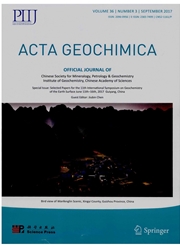

 中文摘要:
中文摘要:
从金海湖的一个 475 厘米的长沉积核心(QH-2005 ) 被用来执行 18O 和 ostracod 阀门和红色和沉积的谷物尺寸的身体长度的多代理分析,以便重建环境变化在过去的 13500 cal 期间。BP。年龄模型为木质素为体积 orgnic 碳(BOC ) 和 2 个 14C 日期基于 6 个 14C 日期。木质素 14C 日期比相应的层 BOC 14C 日期显然年轻,显示水库年龄从 728 ~ 1222 变化了一后来晚冰川并且从 2390 ~ 2490 一立即在预先轰炸时代前。因此,为核心 QH-2005 的 14C 年龄模型到变化水库年龄被改正。Ostracod 18O 价值主要与冲淡和湖水的成为蒸气的丰富有关。基于 ostracod,身体长度与 ostracod 18O 价值与一致很好的重建的咸度。高红色和价值显示的吝啬的谷物尺寸(MZ ) 增加了河流的供应到与增加季风降雨联系的金海湖。多代理结果在 1350010900 cal 期间显示出那气候。BP 与经常的短期的变化相对冷、干燥;温暖、湿的气候在大约 10900 cal 开始了。BP 并且在 6500 cal 附近达到顶点。由于季风加强的 BP;气候以后变得冷、干燥并且自从 3400 cal,仍然保持相对稳定。BP。我们的数据也揭示短期(千年 / 一百年的 timescales ) 包括的气候的变化:更年轻的 Dryas 事件,冰木排事件 8 和 1 (由 11000 cal。BP 和 1600 cal。BP 分别地) , 8200 cal。一个 BP 冷事件,很少冰川期和中世纪的温暖的时期。
 英文摘要:
英文摘要:
A 475-cm long sediment core (QH-2005) from Lake Qinghai was used to carry out multi-proxy analysis of 6180 and body length of ostracod valves and redness and grain size of sediments, in order to reconstruct environmental changes during the past 13500 cal. a BP. The age model was based on 6 14C dates for bulk orgnic carbon (BOC) and 2 14C dates for lignin. The lignin 14C dates are apparently younger than the corresponding layers' BOC 14C dates, indicating that the reservoir age varied from 728 to 1222 a since the Late Glacial and from 2390 to 2490 a immediately before the pre-bomb era. Hence, the 14C age model for Core QH-2005 was corrected by the changing reservoir age. Ostracod δ18O values were primarily related to dilution and evaporative enrichment of the lake water. The reconstructed salinity based on ostracod body length coincides well with ostracod δ18O values. High redness and mean grain size (MZ) values indicate increased riverine supply to Lake Qinghal associated with increasing monsoon rainfall. Multi-proxy results show that climate during 13500-10900 cal. a BP was relatively cold and dry with frequent short-term fluctuations; a warm and wet climate began at about 10900 cal. a BP and culminated around 6500 cal. a BP as a result of monsoon strengthening; the climate became cold and dry afterwards and has remained relatively stable since 3400 cal. a BP. Our data also reveal short-term (millennial/centennial timescales) climatic fluctuations including: Younger Dryas events, ice-rafting events 8 and 1 (by -11000 cal. a BP and -1600 cal. a BP respec- tively), 8200 cal. a BP cold event, Little Ice Age and the Medieval Warm Period.
 同期刊论文项目
同期刊论文项目
 同项目期刊论文
同项目期刊论文
 A high-resolution climatic change since Holocene inferred from multi-proxy of lake sediment in weste
A high-resolution climatic change since Holocene inferred from multi-proxy of lake sediment in weste Uplift events of the Qinghai-Tibetan Plateau and environmental evolution of the southwest monsoon si
Uplift events of the Qinghai-Tibetan Plateau and environmental evolution of the southwest monsoon si The variation of the southwest monsoon from the high resolution pollen record in Heqing Basin, Yunna
The variation of the southwest monsoon from the high resolution pollen record in Heqing Basin, Yunna Environmental change during the past 13500 cal. a BP deduced from lacustrine sediment records of Lak
Environmental change during the past 13500 cal. a BP deduced from lacustrine sediment records of Lak Variability of Indian summer monsoon since 18 cal. kyr BP inferred from the sediment records of Lake
Variability of Indian summer monsoon since 18 cal. kyr BP inferred from the sediment records of Lake Comparison between OSL and 14C dating of late Quaternary lacustrine sediment from Qaidam Basin and T
Comparison between OSL and 14C dating of late Quaternary lacustrine sediment from Qaidam Basin and T 期刊信息
期刊信息
